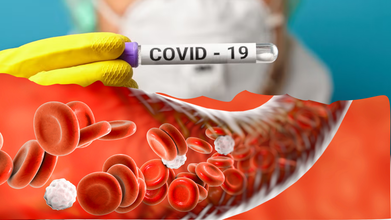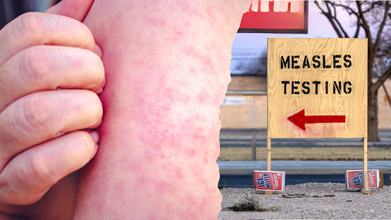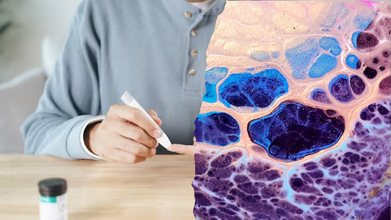- Health Conditions A-Z
- Health & Wellness
- Nutrition
- Fitness
- Health News
- Ayurveda
- Videos
- Medicine A-Z
- Parenting
- Web Stories
More Americans Than Ever Are Depressed With Most Not Receiving Treatment, CDC Reveals

Credits: Canva
A shocking new CDC report shows that an unprecedented number of Americans are dealing with depression, yet most aren't receiving the care they require. From drowning teenagers to burnout adults, this epidemic mental health crisis runs deeper and more widespread than many think but what's behind this epidemic exactly? And why is treatment still beyond reach for so many? Depression has hit record high levels — reaching more than 1 in 8 Americans 12 years of age and older, says new information recently made public. The upward swing is alarming, yet most of those living with depression go untreated, which indicates not only a crisis of health but also a profound disconnect in access, awareness, and acceptance of mental health treatment.
Between 2015 and 2023, the percentage of Americans who reported depressive symptoms has almost doubled — increasing from 7.3% to more than 13%, the National Health and Nutrition Examination Survey (NHANES) reports. This increase is especially steep among teens and women, two cohorts that are facing intense psychological pressure in the aftermath of the pandemic.
Teenagers aged 12 to 19 reported the highest levels of depression, with 19% reporting symptoms in the last two weeks—a dramatic number that underscores the teen mental health crisis. Women are also disproportionately impacted, with 16% reporting depression versus 10% of men, highlighting a major gender disparity in mental health outcomes. By comparison, people over 60 years reported having the lowest level of depression at a mere 9%, raising the potential linkage between life stability, age, or accessibility of coping tools and younger cohorts who may be bereft thereof.
Teenage girls are particularly at risk — over 1 in 4 teen girls suffer from clinical depression, the largest affected group. At the same time, the CDC's Youth Risk Behavior Survey gives a grim picture, 53% of high school girls said they often felt sad or hopeless — almost twice as many boys and 14 points more than a decade ago.
Why Most People Aren't Getting Treated?
And perhaps the most unsettling part of the CDC report is the huge treatment gap. Although 88% of those surveyed did admit that depression affected work, school, and social life — just around 40% were given any kind of counseling or therapy.
Women are more likely than men to go to therapy (43% vs 33%), and they're over twice as likely to be on antidepressant medication. Yet most adolescents — while having higher levels of depression — are less likely to be on medication, creating an imbalance between need and treatment.
Socioeconomic status also comes into play: individuals with higher incomes had lower rates of depression, and most likely had greater access to mental health care.
How COVID-19 Changed Everything?
The surge in depression tracks perfectly with the social and psychological impact of the COVID-19 pandemic. Disruption of routine, extended isolation, loss of loved ones, economic uncertainty, and uncertainty about the future converged into a perfect storm of mental tension.
Additionally, shifts in how the NHANES survey was conducted during the pandemic could have impacted reporting, but experts say the increase in symptoms is too uniform across demographics to be an artifact of statistics.
What Untreated Depression Does to the Body?
Clinical depression isn’t just an emotional struggle; it fundamentally alters brain function and structure. Functional imaging studies reveal abnormalities in the ventral limbic system — a brain region responsible for regulating emotions and bodily functions.
Untreated depression has been found to cause shrinkage in the hippocampus, thalamus, amygdala, and prefrontal cortex, all of which are linked to mood and cognitive function. These alterations can exacerbate the severity of the condition over time, and recovery becomes more challenging.
Also, depression left untreated disables neurotransmitter function — possibly derailing communication between areas of the brain. Whether or not this is an effect or cause of the illness is uncertain, but the result is the same: ongoing suffering without adequate medical or therapeutic intervention.
Physical Cost of Ignoring Mental Health
Clinical depression is a physical health hazard as well. Research indicates that individuals with major depression who are recovering from heart attacks or strokes have difficulty in adhering to medical instructions, controlling symptoms, and making treatment choices. These patients are also at increased risk of premature mortality within months of a cardiac condition.
This highlights the need to consider mental health care as part of general health — not a luxury or an add-on.
Selective serotonin reuptake inhibitors (SSRIs) — a widely used group of antidepressants — have been in the public eye recently. US Secretary of Health Robert F. Kennedy Jr. has made false claims that SSRIs are potentially more addictive than heroin, something not backed by existing evidence.
Yet, figures from Truveta, a prominent health analytics company, indicate that trends in antidepressant prescriptions since 2018 have been stable, albeit for a brief surge in the early years of the pandemic. This is contrary to fears of overprescription and may indicate that dependency fears are exaggerated.
The increasing mental health load — particularly among women and adolescents — necessitates immediate policy response. Stepping up access to affordable counselling, increasing school-based mental health clinics, combating stigma in hard-to-reach communities, and an investment in preventative care are necessary measures.
Unusual Side Effect Of COVID That Puts Women At Greater Health Risk

Credits: Canva
When Covid-19 initially emerged, most of the world's attention was on its up-front effects- respiratory distress, loss of taste and smell, and the sheer tidal wave of hospitalization. But almost five years into the pandemic, researchers are discovering a much more subtle effect-Covid could be advancing the aging of the cardiovascular system, raising the risk of heart attack and stroke in the background even after patients recover.
A fresh global study in the European Heart Journal indicates that catching Covid may speed up blood vessel ageing by up to five years. Vascular stiffening was strongest in women, with new concerns over sex-based risks and long-term health outcomes of the virus.
Dangerous Hidden Side Effect of Covid Infection
The research, known as the CARTESIAN study, evaluated nearly 2,400 participants from 16 countries between 2020 and 2022. Participants were divided into four groups: those who had never contracted Covid, those who had Covid but were never hospitalized, those hospitalized on a general ward, and those who required intensive care.
To measure the health of their arteries, scientists used a tool that assesses carotid-femoral pulse wave velocity (PWV)—a measure of how fast blood pressure waves travel through the body. The faster the wave moves, the stiffer and “older” the arteries are considered to be. PWV is a reliable predictor of cardiovascular health and future risk of events like stroke or heart attack.
Measurements were taken six months after infection and repeated at the 12-month mark. Across all groups, researchers observed that patients who had been infected with Covid showed stiffer arteries than those who never contracted the virus.
Why Women Are At Higher Risk?
The study’s most striking finding was how differently Covid affected men and women. Women with even mild Covid showed an average PWV increase of 0.55 meters per second.
Hospitalized women recorded an increase of 0.60. Women who had been admitted to the ICU saw a surge of 1.09.
These increases are not just academic. An acceleration of 0.5 meters per second is considered clinically significant, equating to about five years of vascular ageing. For a 60-year-old woman, that change translates into a three percent higher risk of cardiovascular disease, including heart attacks and strokes.
Men, by contrast, did not exhibit statistically significant vascular changes. Lead author Professor Rosa Maria Bruno of Université Paris Cité explained the likely reason, “Women mount a more rapid and robust immune response, which can protect them from infection. However, this same response can also increase damage to blood vessels after the initial infection.”
In other words, the very strength of the female immune system may paradoxically expose women to greater long-term risks after Covid.
Protective Role of Vaccination
The study also highlighted another crucial factor: vaccination.
Vaccinated women showed less stiffening in their arteries compared with their unvaccinated counterparts, and their vascular symptoms stabilized over time. While men didn’t show the same measurable benefit in PWV reduction, vaccination still appears to offer indirect protection by preventing severe disease and hospitalizations, which were correlated with worse outcomes.
This aligns with earlier evidence suggesting that vaccines not only reduce the risk of contracting Covid but may also blunt some of the lingering cardiovascular effects of the virus.
Why Blood Vessels Age Due To Covid Infection?
Covid is often thought of as a respiratory illness, but the virus has long been known to attack blood vessels directly. The culprit lies in ACE2 receptors, which line the inside of blood vessels and serve as gateways for the virus to enter cells. Once inside, Covid can trigger inflammation and damage to vascular tissue.
Over time, this damage results in stiffer arteries—an early warning sign of cardiovascular disease. Unlike symptoms such as cough or fever, vascular ageing can occur silently, without obvious warning until it manifests as a serious cardiac event.
The vascular ageing discovery adds to a growing list of long-term complications associated with Covid, from brain fog and chronic fatigue to lung scarring and diabetes risk. What makes this new finding particularly concerning is its potential scale.
Cardiovascular disease is already the leading cause of death worldwide. If Covid is accelerating vascular ageing across millions of people—especially women—the global burden of heart attack and stroke could rise significantly in the years ahead.
Professor Bruno underscored this urgency:
“If that is happening, we need to identify who is at risk at an early stage to prevent heart attacks and strokes.”
Why Is There A Gender Divide in Covid Outcomes?
Throughout the pandemic, gender differences in Covid outcomes have puzzled researchers. Men were more likely to die from acute Covid infection, yet women appear to face greater long-term risks from conditions like long Covid and, now, vascular ageing.
This paradox may reflect differences in immune system behavior. Women’s stronger immune responses provide better initial protection but may lead to more sustained inflammation—a double-edged sword that continues damaging the body even after the infection clears.
What Can Women Do To Stay safe?
While the research continues to evolve, several practical takeaways emerge from this study:
Stay up to date on vaccination: Protection against severe Covid seems to reduce the risk of long-term vascular consequences, especially for women.
Prioritize cardiovascular screening: People who have had Covid—particularly those with persistent symptoms—may benefit from blood pressure checks, vascular assessments, and cardiac monitoring.
Adopt heart-healthy habits: Exercise, balanced nutrition, and avoiding smoking remain powerful tools to offset vascular ageing.
Pay attention to symptoms: Shortness of breath, chest pain, or unexplained fatigue after Covid should be evaluated promptly by a healthcare professional.
Just last month, a new Covid variant, the Stratus strain, emerged in the UK, accounting for nearly one-third of cases. With its ability to partially evade immunity and cause unusual symptoms such as hoarseness, the variant is a reminder that Covid continues to evolve.
If each wave of infection carries hidden long-term risks like vascular ageing, the urgency of global vaccination campaigns and ongoing surveillance becomes even clearer.
Measles Outbreak Declared Over In Texas After More Than 700 Were Infected, Say Health Officials

Credits: iStock/AP
After months of relentless effort, Texas health officials have declared the end of the measles outbreak that gripped West Texas, one of the largest and deadliest in the United States in decades. The Texas Department of State Health Services (DSHS) announced on Monday that it has been more than 42 days—two full measles incubation periods since the last reported case in affected counties, meeting the threshold to officially declare the outbreak over.
The scale of the outbreak was sobering: at least 762 confirmed cases since late January, nearly 100 hospitalizations, and two school-aged children in Texas who lost their lives the first measles deaths in the U.S. since 2015.
“This point marks the result of tireless work from public health professionals across the state,” said Dr. Jennifer Shuford, commissioner of DSHS. “We contained one of the most contagious viruses through testing, vaccination, disease monitoring, and public education. Many health care professionals confronted measles cases in person for the very first time in their careers.”
This outbreak wasn’t just another cluster of cases. It marked a turning point in the nation’s struggle to maintain measles elimination status, which the U.S. first achieved in 2000.
Cases tied to the Texas outbreak were also reported in New Mexico, Oklahoma, and possibly Kansas. New Mexico confirmed 100 cases, including one death, and still considers its outbreak ongoing. Nationwide, more than 1,350 measles cases have been reported this year alone—the highest number in more than three decades, accounting for over half of the cases since elimination was declared.
What made Texas particularly vulnerable? Vaccination gaps. The majority of cases came from in and around Gaines County, where measles-mumps-rubella (MMR) vaccination rates among kindergartners rank among the lowest in the state. Data from the U.S. Centers for Disease Control and Prevention (CDC) shows that more than 90% of cases nationwide were in unvaccinated individuals. Only 8% were in people with at least one MMR dose.
The outbreak’s origins were initially linked to a Mennonite community in West Texas, underscoring how pockets of low vaccination coverage can act as a spark for widespread transmission.
How Did The Outbreak Finally End?
Measles is considered one of the most contagious viruses known—each infected person can transmit it to up to 18 others in unvaccinated populations. Declaring an outbreak “over” requires more than just a lull in cases. Health officials wait through at least two incubation periods (21 days each) without new reports, to ensure that hidden chains of transmission have truly been cut off.
This timeline makes Monday’s announcement a milestone, but officials emphasize it does not mean measles is gone for good. “The end of this outbreak does not mean the threat of measles is over,” the Texas health department said. “With ongoing outbreaks in North America and worldwide, more cases are likely this year in Texas.”
Warning Signs Across the Country
Texas may be closing this chapter, but measles remains a national and global threat. Colorado recently reported a new case in Grand Junction—an unvaccinated adult with no travel history, suggesting local spread. This brings Colorado’s case total for 2025 to 20, compared with just five cases over the entire previous decade.
In New Jersey, state health officials issued a warning after a measles-infected traveler passed through Newark International Airport on July 29 and 30. Six cases have been confirmed there so far this year.
Such warnings are becoming increasingly common. At least 41 U.S. states have reported measles cases in 2025. The troubling backdrop is falling vaccination coverage: more incoming kindergartners are entering school with exemptions, most often for personal or religious reasons. The CDC confirms that last school year saw a record-high share of vaccine exemptions among children starting school.
Why Vaccination Is Still The Deciding Factor?
Measles is not only highly contagious—it is also highly preventable. The MMR vaccine offers about 97% protection after two doses. The problem is not the science; it’s coverage.
Experts note that communities require at least 95% vaccination rates to maintain “herd immunity,” the collective protection that prevents outbreaks from taking hold. Pockets of low coverage, whether due to misinformation, hesitancy, or lack of access, create cracks in that shield.
The West Texas outbreak is a clear example of how quickly measles can spread when those cracks widen. It also serves as a warning that elimination status is not invincibility.
The end of the outbreak in Texas reflects months of coordinated effort- surveillance, lab testing, rapid vaccination campaigns, and public education. But the larger lesson is about prevention.
“This outbreak shows what happens when vaccination rates slip,” said Dr. Shuford. “The best defense against measles is ensuring every eligible child and adult is protected.”
The virus has shown its ability to exploit vulnerabilities, whether in rural counties with low coverage or major travel hubs like airports. In an era of global travel, measles anywhere is a threat everywhere.
While Texas celebrates the end of this outbreak, the work is far from finished. Public health leaders continue to stress the importance of routine vaccination not just for measles but for all vaccine-preventable diseases.
Man With Diabetes Produces Own Insulin After World’s First Gene-Edited Cell Transplant

Credits: Freepik
A 42- year-old man with type 1 diabetic begna making his own insulin without daily shots or anti-rejection medication. The breakthrough, published in the New England Journal of Medicine, is being hailed as the most promising advancement on the way to a functional cure for type 1 diabetes, an autoimmune disease that afflicts nearly 9.5 million people globally. It signaled the start of a diabetes revolution. For the first time, researchers have been able to transplant genetically modified islet cells into a human patient, allowing the body to produce insulin naturally and prevent immune rejection—a hurdle that has hampered advances for decades.
Type 1 diabetes develops when the immune system attacks and destroys the pancreatic islet cells that make insulin. In its absence, the body is unable to control blood sugar, and patients must depend on man-made insulin injected or pumped into the body.
Although insulin therapy is life-saving, it cannot duplicate the body's subtle sensitivity to provide insulin in anticipation of meals. That leaves even the most compliant patients with wild swings in blood glucose that heighten long-term risks of heart disease, kidney failure, and nerve damage.
Scientists have been working for a long time to replace natural insulin production with islet cell transplants. But there has always been one obstacle: rejection. The immune system is programmed to recognize donor cells as foreign and destroy them. To avoid this, recipients of transplants have to take immunosuppressive drugs for the rest of their lives. The drugs are effective, but they expose patients to infections, cancer, and organ injury—a trade-off that has kept cell transplantation from becoming mainstream.
Insulin Production Without Immune Suppression
For this new patient, who was diagnosed with type 1 diabetes at the age of 5, a healthy donor islet cells were given. Rather than injected into the pancreas, the cells were given through a series of injections into the muscle of his forearm. This made it easier for doctors to check on the graft and lower surgical risks.
During the 12-week period, the transplanted cells started secreting insulin when there were high levels of glucose, like after meals. Most significantly, the patient did not need any immunosuppressant medications. His immune system merely left the cells alone—a feat that had never previously been achieved in humans.
What Role CRISPR Gene Editing Play?
The breakthrough was dependent on genetic engineering. Scientists applied the CRISPR gene-editing mechanism to make three critical modifications to the cells before they were transplanted:
Diminishing immune "flags": Two edits reduced amounts of antigens that T cells typically employ to recognize foreign cells.
Augmenting defense with CD47: The third edit boosted levels of CD47, a protein assigned the codename "don't eat me" signal, which deters natural killer cells and macrophages from targeting.
Surprisingly, not every cell got the full complement of edits. The unedited ones were rapidly killed by the immune system. The partially edited cells survived a bit longer but were eventually rejected. Only the fully edited cells persisted—and they were the ones that achieved the successful production of insulin. This natural experiment within the body of the patient proved that the three-edit approach was the solution.
How This Means Future of Diabetes Treatment Is Closer Than Ever?
Even though the patient was given a modest amount of the engineered cells and still needs daily insulin, the outcome is a proof of concept that cell transplants are possible without immunosuppression. That in itself is a game changer.
If additional research verifies the longevity and safety of this method, it may drastically increase access to islet cell transplantation. Patients would be able to obtain more stable blood sugar levels, lowering complications and enhancing quality of life. Larger grafts or multiple transplants over time may even render insulin treatment obsolete.
The breakthrough follows a wave of experimental treatments for type 1 diabetes. In 2022, a woman in China underwent insulin-producing cells derived from her own stem cells, which made her able to sustain stable blood glucose without injections for months. Gene-edited islet cells have also produced encouraging results in animal trials.
© 2024 Bennett, Coleman & Company Limited

